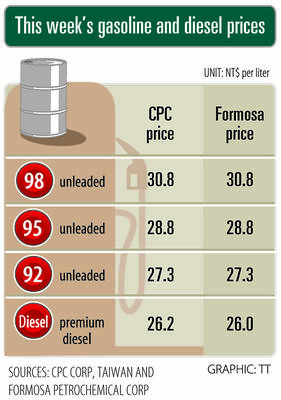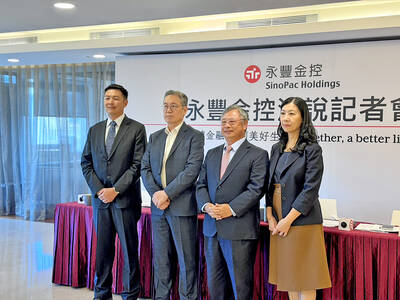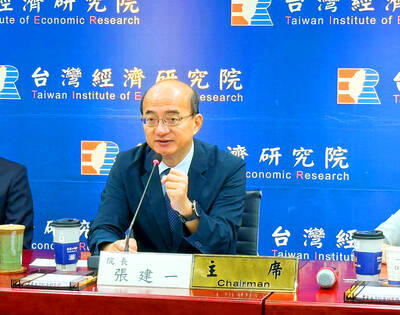Swancor Holding Co (上緯投控) yesterday said that it has closed a deal to sell a 95 percent stake in Swancor Renewable Energy Co (上緯新能源) to New York-based Stonepeak Oceanview Holdings Co for between US$25 million and US$101 million.
Swancor Renewable Energy is Swancor Holding’s renewable energy and offshore wind farm subsidiary.
The gains from share sale are estimated at US$9.99 million to US$85.47 million, Swancor Holding said in a filing with the Taiwan Stock Exchange.
The company, whose core business includes resins and composite materials manufacturing, said the sale is part of its plan to expand the production of composite materials for wind turbines in Taiwan.
The company first disclosed its intention to sell its shares in Swancor Renewable Energy in June, prompting speculation that it would completely exit the offshore wind farm business.
However, as Swancor Renewable Energy owns a 25 percent stake in Formosa II Wind Power Co (海能風力發電), which is working on a 376 megawatt project due to be completed by the end of next year, Swancor Holdings still holds a 1.25 percent stake in the wind farm being built off Miaoli County’s Jhunan Township (竹南).
Swancor Holding is also developing the second phase of Formosa I Wind Power Co (海洋風力發電), Taiwan’s first offshore wind farm, also off the Miaoli coast. It installed the first wind turbine last week.
The project would be completed by the end of the year, it said.
The share sale is Stonepeak’s first step into Asia’s renewable energy market. The company had mostly focused on investments in North America.
Managing more than US$15 billion of capital for its investors, Stonepeak would seek out renewable energy markets in Japan, South Korea and Southeast Asia through its investment in Swancor Renewable Energy, it said.

SETBACK: Apple’s India iPhone push has been disrupted after Foxconn recalled hundreds of Chinese engineers, amid Beijing’s attempts to curb tech transfers Apple Inc assembly partner Hon Hai Precision Industry Co (鴻海精密), also known internationally as Foxconn Technology Group (富士康科技集團), has recalled about 300 Chinese engineers from a factory in India, the latest setback for the iPhone maker’s push to rapidly expand in the country. The extraction of Chinese workers from the factory of Yuzhan Technology (India) Private Ltd, a Hon Hai component unit, in southern Tamil Nadu state, is the second such move in a few months. The company has started flying in Taiwanese engineers to replace staff leaving, people familiar with the matter said, asking not to be named, as the

The prices of gasoline and diesel at domestic fuel stations are to rise NT$0.1 and NT$0.4 per liter this week respectively, after international crude oil prices rose last week, CPC Corp, Taiwan (台灣中油) and Formosa Petrochemical Corp (台塑石化) announced yesterday. Effective today, gasoline prices at CPC and Formosa stations are to rise to NT$27.3, NT$28.8 and NT$30.8 per liter for 92, 95 and 98-octane unleaded gasoline respectively, the companies said in separate statements. The price of premium diesel is to rise to NT$26.2 per liter at CPC stations and NT$26 at Formosa pumps, they said. The announcements came after international crude oil prices

SinoPac Financial Holdings Co (永豐金控) is weighing whether to add a life insurance business to its portfolio, but would tread cautiously after completing three acquisitions in quick succession, president Stanley Chu (朱士廷) said yesterday. “We are carefully considering whether life insurance should play a role in SinoPac’s business map,” Chu told reporters ahead of an earnings conference. “Our priority is to ensure the success of the deals we have already made, even though we are tracking some possible targets.” Local media have reported that Mercuries Life Insurance Co (三商美邦人壽), which is seeking buyers amid financial strains, has invited three financial

CAUTION: Right now, artificial intelligence runs on faith, not productivity and eventually, the risk of a bubble will emerge,’ TIER economist Gordon Sun said Taiwanese manufacturers turned more optimistic last month, ending a five-month streak of declining sentiment as concerns over US tariffs, currency volatility and China’s overcapacity began to ease, the Taiwan Institute of Economic Research (TIER) said yesterday. The manufacturing business confidence index rose 1.17 points from June to 86.8, its first rebound since February. TIER economist Gordon Sun (孫明德) attributed the uptick to fading trade uncertainties, a steadier New Taiwan dollar and reduced competitive pressure from Chinese producers. Taiwan’s semiconductor industry is unlikely to face significant damage from Washington’s ongoing probe into semiconductors, given the US’ reliance on Taiwanese chips to power artificial